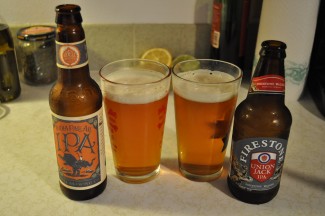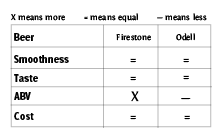Welcome to the Hop Vine — column on all things related to beer. Topics include, but are not limited to beer reviews and comparisons, homebrewing tips and recipes, events around town and reader Q-and-A.
Beer Comparison
This week, I compared two India Pale Ales (IPAs) that are fairly common in the area. For those who don’t know the difference between an IPA and regular pale ale, IPA beer uses more hops than pale ale and is more bitter as a result. They can also be more floral, fruity, spicy, piney, earthy, skunky etc., depending on the hop varieties used.

Silas Whitley | Crumbs
Odell IPA and Firestone Walker Union Jack IPA display the versatility of hop use in beer. Two similar, excellent choices for IPA enthusiasts.

Silas Whitley
The two IPAs I chose were Odell Brewing Company India Pale Ale from Fort Collins, Colorado, and Firestone Union Jack IPA, from Firestone Walker Brewing Company, Paso Robles, California. These beers were both the same price, $1.79, which is not a bad deal. The Firestone weighs in at 7.5 percent alcohol by volume, ABV, compared to the Odell 7 percent.
Both beers were similar in malt flavor. They both had a crisp and clean finish. They both were roughly the same color, but the Odell beer was slightly darker. They had about the same amount of head. To an inexperienced IPA drinker, they might be passable as the same.
The most noticeable difference between the two is the hops used. The Firestone IPA was more upfront with its hop flavor, so it was noticeable right away, while the Odell hop flavor took a second to hit the palate. The Odell IPA hops were more citrusy and had a slightly sweeter taste than the Firestone hops, which were somewhat floral and spicy.
Overall, I enjoyed both beers equally. I think they are very similar in base, but both display the versatility of hop use in beer making. Try each to decide which beer is best. Those who like semi-subjective tables to base purchase decisions on, I’ve designed one with the most basic components college students are likely to consider when buying alcohol … with the exception of both smoothness and taste, but I included them anyways.
 Homebrewing Tips
Homebrewing Tips
This week is a good week to touch on hop use in homebrew. While trying to brew an IPA or any other hoppy beer, make sure to choose the right type of hops for the desired style of brew. For instance, from experience, using Simcoe hops for a dark beer is likely not the best choice. Just because you like a certain type of hops doesn’t mean it will go well with the beer’s style.
Make sure also the hops complement each other. A good way to do this would be to use hop substitution chart, or to read the description of the hops on the packages to make sure they are similar.
Another tip for hop use is if flavor is wanted but the bitterness isn’t — don’t add hops to the brew until 30 minutes of boil time is left. The 60 to 30 minute time frame is used for bittering (generally high alpha acid) hops. Nothing requires hops to be added at 60 minutes. Try experimenting with hop time additions.
Also, don’t be afraid to dry hop. Flavors can be extracted from hops that otherwise would be altered during the boiling process. When dry hopping — adding dry hops to secondary fermentation — don’t worry about introducing bacterial infections, as the alcohol content of beer and establishment of a high yeast population should prevent bacterial growth.
Miscellaneous
Questions? Comments? I’ll be happy to answer them in my next article.
Silas Whitley can be reached at [email protected]
